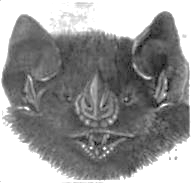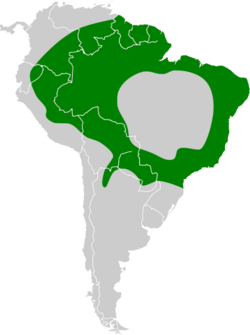Biology:Flat-faced fruit-eating bat
| Flat-faced fruit-eating bat | |
|---|---|

| |
| Scientific classification | |
| Domain: | Eukaryota |
| Kingdom: | Animalia |
| Phylum: | Chordata |
| Class: | Mammalia |
| Order: | Chiroptera |
| Family: | Phyllostomidae |
| Genus: | Artibeus |
| Species: | A. planirostris
|
| Binomial name | |
| Artibeus planirostris (Spix, 1823)
| |

| |
| Synonyms | |
|
Artibeus jamaicensis planirostris | |
The flat-faced fruit-eating bat (Artibeus planirostris) is a South American species[1] of bat in the family Phyllostomidae. It is sometimes considered a subspecies of the Jamaican fruit bat,[2] but can be distinguished by its larger size, the presence of faint stripes on the face, and of a third molar tooth on each side of the upper jaw. Genetic analysis has also shown that the two species may not be closely related.[3]
Description
Flat-faced fruit-eating bats are moderately sized bats, with adults measuring 8 to 11 centimetres (3.1 to 4.3 in) in total length and weighing 40 to 69 grams (1.4 to 2.4 oz). The fur is brownish-grey over most of the body, becoming grey on the underparts, although there are faint whitish stripes on the face. As their name suggests, the bats have a broad skull with a short snout. The ears are triangular, with rounded tips, although short compared with those of many other bats, and with a small tragus. The snout bears a prominent triangular nose-leaf. The wings are dark brown or blackish, with white tips. A well-developed uropatagium stretches between the legs, but there is no visible tail.[3]
Distribution and habitat
Flat-faced fruit-eating bats are found through much of northern and central South America east of the Andes. They inhabit a range of forested environments from sea level to 2,000 metres (6,600 ft) elevation, including montane, transitional, and lowland tropical forests and open cerrado habitats. Three subspecies are currently recognised:[3]
- Artibeus planirostris planirostris - eastern Brazil , Paraguay
- Artibeus planirostris fallax - southern Venezuela and Colombia, the Guyanas, through central and western Brazil to eastern Bolivia and extreme northern Argentina
- Artibeus planirostris hercules - eastern Peru, eastern Ecuador
Behaviour and biology
Flat-faced fruit-eating bats are nocturnal and herbivorous. They feed almost entirely on fruit, although they may also eat small quantities of insects and mites.[4] They are active throughout the night, and spend the day roosting in trees.[5] Favoured fruit include those of Vismia trees, figs, and Amazon grape.[3] They are apparently capable of breeding throughout the year, although, in at least some areas, births are more common during the wet season. Gestation lasts at least three and a half months, and results in the birth of a single young.[3]
References
- ↑ 1.0 1.1 Barquez, R.; Diaz, M. (2015). "Artibeus planirostris". IUCN Red List of Threatened Species 2015: e.T2139A21997607. doi:10.2305/IUCN.UK.2015-4.RLTS.T2139A21997607.en. https://www.iucnredlist.org/species/2139/21997607. Retrieved 13 November 2021.
- ↑ Template:MSW3 Simmons
- ↑ 3.0 3.1 3.2 3.3 3.4 Hollis, L. (2005). "Artibeus planirostris". Mammalian Species 775: Number 775: pp. 1–6. doi:10.1644/1545-1410(2005)775[0001:AP2.0.CO;2].
- ↑ Willig, M.R. (1993). "Dietary overlap in frugivorous and insectivorous bats from edaphic Cerrado habitats of Brazil". Journal of Mammalogy 74 (1): 117–128. doi:10.2307/1381910.
- ↑ Davis, W.B.; Dixon, J.R. (1976). "Activity of bats in a small village clearing near Iquitos, Peru". Journal of Mammalogy 57 (4): 747–749. doi:10.2307/1379444.
Wikidata ☰ Q308267 entry
 |


